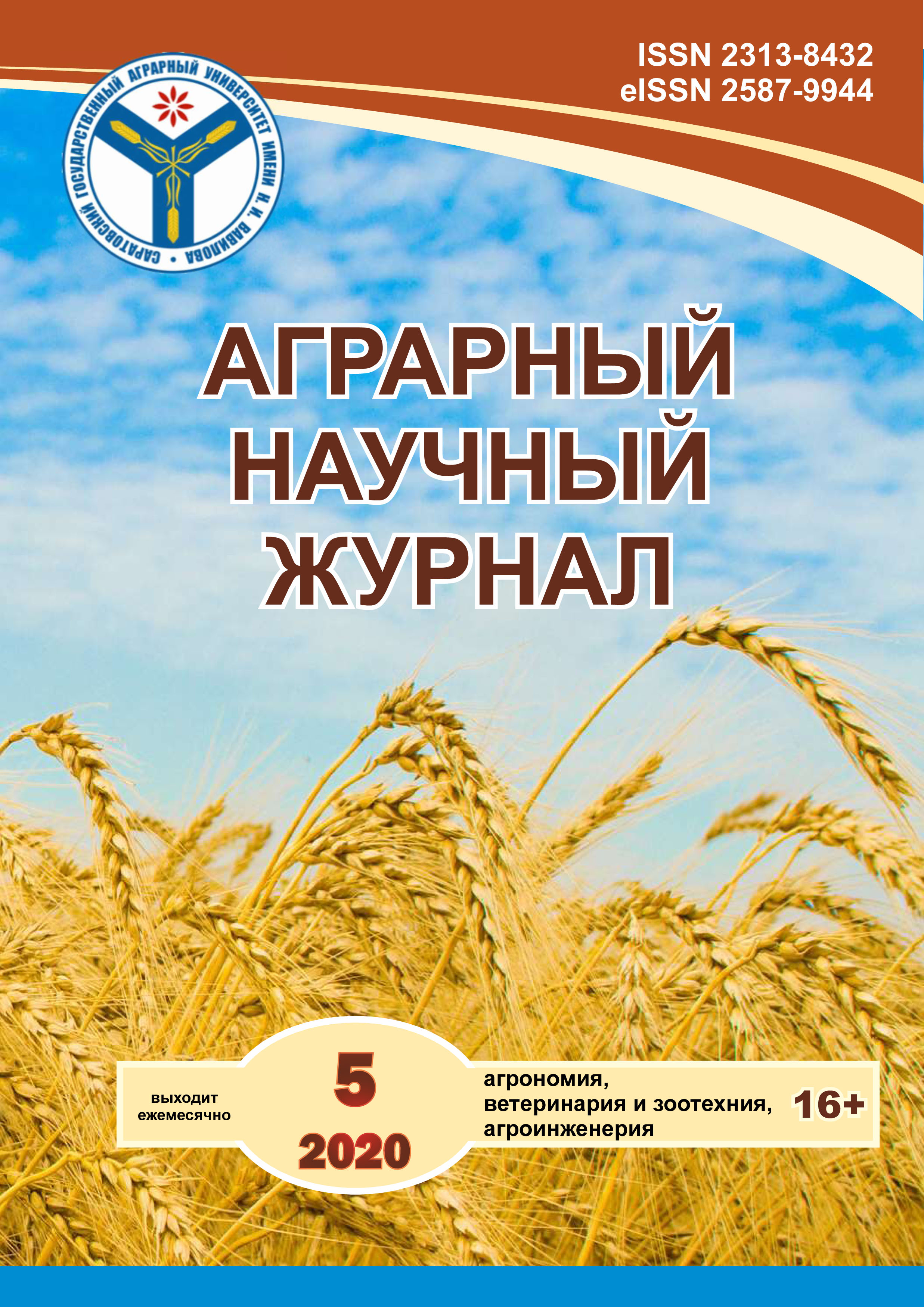Influence of polymorphism of complex of csn3 and lgb genes on the dairy productivity in holstein cattle
DOI:
https://doi.org/10.28983/asj.y2020i5pp64-67Keywords:
gene, genotype, polymorphism, kappa-casein, beta-lactoglobulin, yield, fat, proteinAbstract
The study presents the results obtained in the course of DNA testing of allelic polymorphism by PCR-RFLP on CSN3 and LGB genes and the associations of their complex genotypes to the indicators of milk productivity of Holstein cow-heifers.Genetic polymorphism was detected by digestion with the endonucleases Hinf I (CSN3) and Hae III (LGB). All integrated CSN3/LGB genotypes were identified during the work. The maximum frequency of occurrence is observed in a combination of heterozygous AB/AB genotypes – 120 animals (25.5%), which is the fourth part of the studied cattle population. The group of animals with homozygous BB/BB genotypes of CSN3/LGB genes is the smallest one – 10 animals (2.1%). Milk productivity test, based on the complex CSN3 and LGB genotypes is observed in heifers with an integrated combination of CSN3BBLGBAAshowed that a significantly high level of productivity for 305 days of lactation – 7239.8 kg, and a minimum level of productivity (6222.9 kg) is observed in heifers with the complex CSN3BBLGBAB genotype, compared with indicators of milk yield of cow-heifers with other integrated genotypes. According to the content of the mass fraction of fat, the best indicators were established in the subpopulation of animals with the complex AA/AB genotype – 3.90%, and the worst result was recorded in the group of animals with the complex AB/AA genotype, which amounted to 3.44%. The high content of the mass fraction of protein was observed in individuals by the complexof the CSN3 and LGB genes BB/AA – 3.43%, and a reduced level of protein was observed in heifers with a combination of homozygous AA/AA and BB/BB genotypes by the genes under study – 3.18%. Thus, individuals carrying the homozygous A allele of the kappa-casein (CSN3) gene and the homozygous B allele of the beta-lactoglobulin (LGB) gene in the integrated genotype favorably differed on the main indicators of milk productivity.
Downloads
References
2. Долматова И.Ю., Валитов Ф.Р. Оценка генетического потенциала крупного рогатого скота по маркерным генам // Вестник Башкирского университета. – 2015. – Т. 20. – № 3. – С. 850–853.
3. Ельчанинов В.В. Номенклатура и биохимические свойства основных сывороточных белков. Бета-лактоглобулин // Сыроделие и маслоделие. – 2009. – № 2. – С. 38–39.
4. Зиннатова Ф.Ф., Алимов А.М., Зиннатов Ф.Ф. Взаимосвязь полиморфизма гена бета-лактоглобулин с молочной продуктивностью у коров и коров-первотелок // Ученые записки Казанской государственной академии ветеринарной медицины им. Н.Э. Баумана. – 2012. – Т. 211. – С. 206–209.
5. Малкин М.Н. Молочная продуктивность и воспроизводительные качества коров красно-пестрой породы, полученных при скрещивании и от разведения «в себе» // Аграрный научный журнал. – 2016. – № 8. – С. 25–28.
6. Сафина Н.Ю., Юльметьева Ю.Р., Шакиров Ш.К. Влияние комплекса полиморфизма генов ?-казеина (CSN3) и пролактина (PRL) на молочную продуктивность коров-первотелок голштинской породы // Молочнохозяйственный вестник. – 2018. – № 1. – С. 74–82.
7. Тюлькин С.В., Ахметов Т.М., Нургалиев М.Г. Технологические свойства молока помесных коров с разными генотипами ?-лактоглобулина в условиях Республики Татарстан // Достижения науки и техники АПК. – 2011. – № 11. – С. 61–62.
8. Шайдуллин Р.Р., Ганеев А.С. Комплексное влияние полиморфизма генов CSN3 и DGAT1 на молочную продуктивность черно-пестрого скота // Вестник Ульяновской государственной сельскохозяйственной академии. – 2017. – № 1 (37). – С. 156–159.
9. Шапканова Е.В. Молочная продуктивность черно-пестрого скота с разными генотипами бета-лактоглобулина // Зоотехния. – 2010. – № 12. – С. 2–3.
10. Alexander L.J. Isolation and characterization of the bovine kappa-casein gene // Eur. J. Biochem., 1988, Vol. 178, P. 395–401.
11. Eggen A., Fries R. An integrated cytogenic and meiotic map of the bovine genome // Anim. Genet., 1995, No. 26, P. 216–236.
12. Erhardt G.J., Juszczak L., Panicke H., Krick-Saleck Genetic polymorphism of milk proteins in Polish Red Cattle: a new genetic variant of ?-lactoglobulin // Journal of Animal Breeding and Genetics, 1998, Vol. 115, P. 63–71.
13. Grosclaude F. Genetic polymorphism of the principal milk proteins in cattle. Relation with quantity, composition and cheese making suitability of milk. INRA Productions Animales 1:5 // Journal of Dairy Science.,1988, No. 74, P. 1730–1742.
14. Luque I., Herr?ez A. Texto ilustrado de biolog?a molecular e ingenier?a gen?tica: conceptos, t?cnicas y aplicaciones en ciencias de la salud // Harcourt, 2001. – 469 p.
15. Medrano J.F., Aguilar-Cordova E. Genotyping of bovine ?-casein loci following DNA sequence amplification // Biotechnology, 1990a, No. 8 (2), P. 144–146.
16. Medrano J.F., Aguilar-Cordova Е. Polymerase chain reaction amplification of bovine ?-lactoglobuline genomic sequences and identification of genetic variants by RFLP analysis // Animal Biotechnology, 1990b, No. 1, P. 73–77.
17. Mitra. A, Schlee. P, Krause. I, Blusch. J, Werner T., Balakrishnan C.R. and Pirchner F. Kappa-casein polymorphisms in Indian dairy cattle and buffalo: A new genetic variant in buffalo // Anim Biotechnol. – 1998. – No 9. – PP. 81-87.
18. V?t??escu-Balcan R.A., Georgescu S.E., Manea M.A., Dinischiotu A., Tesio C.D., Costache M. Analysis of beta-lactoglobulin and kappa-casein genotypes in cattle // Lucr?ri ?tiintifice Zootehnie ?i Biotehnologii, 2007, Vol. 40(1), P. 211–216.
19. Zaglool A.W., Awad A., Araby E. El-Bayomi K.M. Association of ? –Lactoglobulin Gene Polymorphism with Milk Yield, Fat and Protein in Holstein-Friesian Cattle // World’s Veterinary Journal, 2016, No. 6(3), P. 117–122.
20. Zepeda–Batista J.L., Alarc?n–Z??iga B., Ru?z–Flores A., N??ez–Dom?nguez R., Ram?rez–Valverde R. Polymorphism of three milk protein genes in Mexican Jersey cattle // Electron J Biotechnol., 2015, Vol. 18, P. 1–4.








